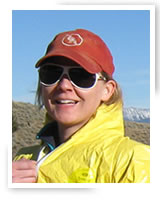Melissa E. Bridges
RESEARCH OVERVIEW:

Non-indigenous plant species distribution modeling: explaining patterns and testing applications for plant community management
Species distribution models are commonly built to predict and map the probability of occurrence of a species of interest. Models describing the geographic distribution of non-indigenous plant species have been promoted as a tool for targeted monitoring for new weed populations. To date, however, there has been little attempt to link plant population dynamics or response to weed management techniques with predicted probabilities of occurrence. Part of my research focuses on characterizing the temporal and spatial dynamics and response to herbicide treatment of three invasive plant species, Linaria dalmatica, Bromus tectorum, and Cirsium arvense, across their gradients of predicted probabilities of occurrence within areas of the Greater Yellowstone Ecosystem.
A recent wave of literature pertaining to species distribution modeling focused primarily
on prediction sparked my interest in elucidating explanations for patterns of non-indigenous
plant distributions. Correctly specifying models whose purpose is to explain rather
than predict could yield generalizations that are useful for tracking and predicting
changes in species distribution patterns in response to changes in climate and land
use. If we ever hope to link plant species distribution patterns with processes,
we must first clearly define the how their patterns of presence and absence vary with
available geographic environmental data and build models that adequately explain those
responses. A major portion of my research centers on explaining patterns of non-indigenous
plant species by characterizing their proportions of occurrences in response to environmental
and land use variables.
Former PhD Student, graduated 2012
Publications while with our WIPEM group:
Bridges M, Maxwell BD, and Rew LJ (2010) The role of current and historical land use in predicting
invasive plant habitat suitability. Society for Range Management and Weed Science Society of America, “Working landscapes
providing for the future”, February 7-11 2010, Denver, Colorado. p80.
Bridges M, Rew LJ, Rotella J, and Maxwell BD (2009) Evaluating the relationship between invasive plant metapopulation growth rate and management efficacy using a modified incidence function model. Poster Presentation. The Ecological Society of America Conference August 2-7, 2009 Albuquerque, New Mexico.
Bridges, M., D.L. Shaner, and P. Westra (2009) The effects of imazamox on feral rye at different
physiological stages. Oral Presentation. 62nd Western Society of Weed Science Annual Meeting. March 10-12. Albuquerque, New Mexico.
Bridges, M., W.B. Henry, D.L. Shaner, R. Khosla, P. Westra, and R. Reich (2008) Spatial variability
of
atrazine and metolachlor dissipation on dryland no-tillage crop fields in Colorado. J. Environ. Qual. 37:2202-2211.
Bridges, M. P. Westra, S.A. Dewey, K.A. Andersen (2008) Generating probability of invasive weed
occurrence maps for aid in precision conservation. Proceedings of the 9th International Conference on Precision Agriculture. July 20-23, 2008. Denver, CO.
Click on an image to view as a slideshow.



